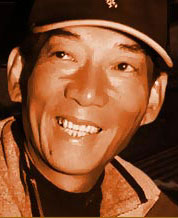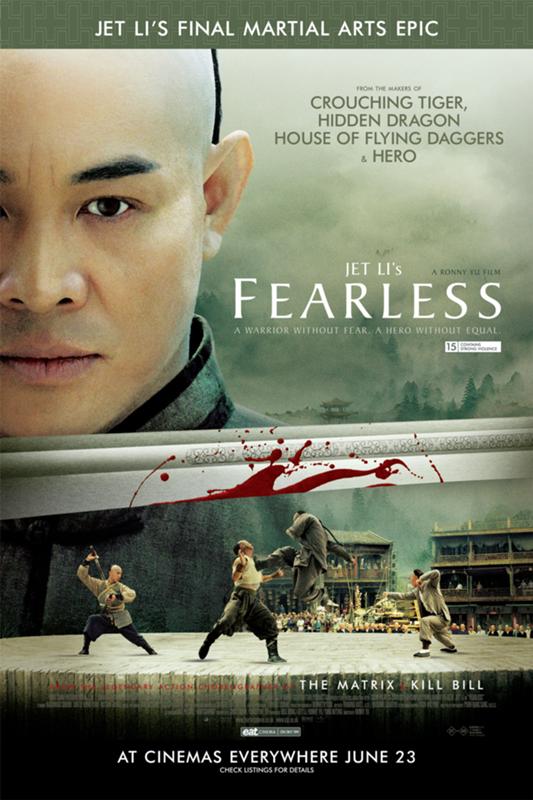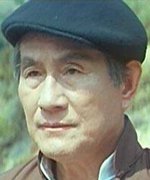
Yuen Woo-Ping
By Cynthia Woehrle
When I found out about this paper and considered who to write about I realized there was one person who I had always wanted to know more about: Yuen Woo Ping. He is a very well known fight and action choreographer; so I wondered, where is his training based, what are his influences, what style of kung fu did he practice, how did he enter the industry?
Here’s what I found out:
Yuen Woo Ping trained at the China Drama Academy under Master Yu Jim Yuen. The China Drama academy was part of the Peking Opera School. Generally students are hand picked at an early age by a sifu and are boarded at the academy. Attending students learned Peking Opera, Martial arts, acrobatics and tumbling and performed these skills for audiences. Many of these schools had closed down after the Japanese invasion in 1931 but the China Drama Academy opened after the war in approximately 1950. Peking opera schools were well known for their harsh rigorous training methods in which the entire group of students would be beaten with bamboo canes for one students mistake during a performance. It is said that the schools that opened after the war were less harsh than previously.
The China Academy produced many students that went onto successful careers in Hong Kong cinema. Such as Jacky Chan, Sammo Hung, Yuen Biao, Yuen, Wah, Corey Yuen, Yuen Qui and of course Yuen Woo Ping. To tell you that anyone of these people trained at the China academy means that they lived breathed and ate training. Generally the day started at 5 am for morning exercises. (Jacky Chan had been quoted in saying that Yu Jim Yuen did not allow students to use the bathroom until the lunch break; the theory being that any toxins in the body would be flushed out in sweat during these exercises.) The remainder of the day would consist of learning skills in acting, weapons, kung fu, stretching, combat, acrobatics and performing. These performances served as income for the school and as also paying the debt the students accumulate during their stay for expenses of food and accommodations. Training took place up to 18 hours a day. All this was part of the contract the students made with the school generally these contracts were for ten years of training and living at the academy. The film “Painted Faces” was based on Master Yu Jim and although it is told from the perspective of Jacky Chan and Sammo Hung’s generation of students it is still able to reflect the training, society and influences that all students Master Yu Jim had, including Yuen Woo-Ping. Master Yu Jim is known also as a northern kung fu practitioner. Many of his students took on Yuen as their sur-name, which is a tradition. I have found information also that Yuen Woo-Ping’s father was also a huge influence on his training – more specifically in the aspect of Kung Fu.
Woo-Ping (meaning Peace) was the oldest of 12 children. He was born in 1945 in Guangzhan China and his father is Yuen Siu Tin. Yuen Siu Tin also trained at the China academy under Master Jim where he graduated to the level of instructor, had a long career with the Peking Opera and was known as an expert. After his graduation Siu Tin taught Kung Fu in Guangzhan. He also performed in black and white Cantonese Custom dramas; credits list him appearing over 100 of these dramas before starting his movie career. It was Siu Tin’s reputation and regard in the industry that helped enable Woo-Ping to launch his career. Actually, five of his children went on to have successful careers in Hong Kong cinema. Siu Tin was cast as a sifu to a young Jacky Chan in “Snake in the Eagles Shadow” (directed by Woo-Ping) this role also boosted his career and he became famous in this genre in 1978 at the age of 67.
That said; Woo-Ping had a deep-set family tradition in Kung Fu, performance, and the film industry. Unfortunately at the time of writing this paper I was unable to discover what style of Kung Fu Woo-Ping and his father practiced and taught. Yuen Woo-Ping carried over his extensive training in Kung Fu and Chinese Opera into an amazingly successful career as a choreographer and director. So, no biography about Woo-Ping would be complete with out an overview of his career.
Woo-Ping started his career after being introduced to the producers of the Wong Fei Hung series in the late 60’s. He developed his film stunt work more when he started working with the Shaw brothers. In 1971 he gets his first credit as a choreographer with the movie “Mad Killer” directed by Ng See Yuen. Ng and Woo-Ping work together again in “Snake in the Eagles Shadow and Drunken Master”
Many of Woo-Ping’s films are favorites amongst fans of Kung Fu movies, whether he has acted in the film, directed it or choreographed it. I believe a lot of this is a testament to the training that was instilled in him when he was younger. It seems as though many elements came together in a unique way for this generation of China Drama Academy. First consider the original intention for training at the drama academy; yes it was for performance but not necessarily for film performance. The film industry has been continually changing and progressing over the past 100 years. I feel that Woo-Ping entered the industry at a great time of opportunity when there was a surge of projects and interest in kung fu films. Hong Kong Cinema – one of three major threads in the history of Chinese language films, alongside Cinema of China and Cinema of Taiwan. It was in the late 60’s that Hong Kong Cinema grew to be the third largest motion picture industry in the World. Its success is due in part to political and economic freedom Hong Kong had from Mainland China. They also became the second largest exporter in the industry in the world. I am sure that there was a lot of competition from other graduates of the Peking Opera schools around the country, and that a few connections in the industry helped him get in but I would not use that question as criticism towards someone who’s career never stopped. Once in he stepped up and did the job. The work ethic and motivation to continually put out movie after movie and to also push the genre is very admirable. He was able to make an impact not only through his skill as a martial artist but as well as being able to convey his vision to actors, stunt men, film crew and other performers and have that vision conveyed through film to an eager audience. Over the course of a 40-year career one would hope to contribute something of substance to what they do. Woo-Ping has certainly done that and has raised the bar for future action film directors.
It would be very cumbersome to analyze all the films he’s done. So I would like to present a few films that represent different stages of his career.
Early films; like “Snake in the Eagles Shadow” “Drunken Master” dating 1978; are in the classic Kung Fu movie style. These are period films that have story lines set in Kung Fu schools demonstrating the students training and development through overcoming obstacles in a certain style as well as personal challenges. These movies reflect a history to kung fu in china (although they may be loosely based on fact and more on legend) the stories of Kung fu are filled with rivalries, revenge, and honor and of course the fight scenes. What fans appreciate about Hong Kong Cinema fight scenes is the physicality behind the stunts the intent and strength in the movements and combinations in the fight scenes; and of course the talent of the stars performing these stunts.
I find his mid career films to be in the early to mid 90’s. “Wing Chun”, “Iron Monkey” and “Once Upon a Time in China” and “Fist of Legend” are all historical films telling the stories behind heroes in Chinese culture- that also did kung fu. It is shortly after this time that Hong Kong was returned to Chinese sovereignty and there was a crisis in the industry about the effect that would have. Despite this major political change Hong Kong Cinema has been able to retain its individuality. It is also in the late 80’s and 90’s that “wire work” in the stunts and fight scenes were utilized in the films. This presented more of a supernatural or super human element to the capabilities of the characters a huge difference when you compare that a character can just naturally fly to the early films that conveyed the grueling training the characters did to achieve their skills.
It was “Fist of Legend” that grabbed the attention of American filmmakers the Wachowski Brothers and they hired him as choreographer for The Matrix. The Matrix is a sci-fi film based in the future. Previous to this film Hong Kong Cinema genre had a strong cult following but the success of “The Matrix” and then the international success of “Crouching Tiger, Hidden Dragon” has taken that following to a more mainstream status in the U.S.
These break through movies in the late 90’s to today has brought him to the American forefront as the most desirable action choreographer to work with and he was subsequently hired to work on Quentin Tarentino’s Kill Bill’s and then the Matrix Sequels. At this time I would like to note the difference In the “wire work” stunts in “Crouching Tiger, Hidden Dragon” and “Hero” 2006 as compared to “Fearless”. The first two films from 2000 and 2002 are epic and beautiful and although there are great hand-to-hand combat scenes the fantasy like “flying element” is still predominant through out the films. The characters engage in battle in the air, on top of trees, can scale walls, all these things are visual eye candy and awe inspiring to the viewer. “Fearless” on the other hand only used the wirework in quick mid air turns. Ryan Pearson described this well when he wrote: “During one fight, Jet Li is knocked off a tall platform. While nearly horizontal, he grabs its edge and flips himself back on. When he’s pushed from a boxing ring, he grabs the top rope with a hand, and puts a foot on a post to bounce smoothly in the opposite direction; such moves are brief and powerful. They require suspended disbelief for just a split second. Then it’s back to the brutal, more realistic on-the-ground battles, where Yuen and Yu focus on Li’s expert footwork.”
Woo-Ping has worked with actors at the onset of their careers who have gone on to also achieve awards an acclaim for their work in film. Such as Jet Li, Michelle Yeoh, Donny Yen, Jacky Chan. His collaborations in the industry have paired into many other projects. Quentin Tarentino helped to bring the film “Hero” to the US big screen; this film featured a fight scene between Jet Li and Donny Yen, who had not been filmed together since “Once Upon a Time in China”. His father Yuen Sui Tin was in many films, mentored Jacky Chan after they worked together in “Drunken Master”, Sui Tin was featured in 35 more films during his lifetime. In 1979 the “Drunken Master” role was reprised for the movie “Magnificent butcher” – this time paired with Sammo Hung and also directed by his son Woo-Ping. Sui Tin died of a heart attack partway through the filming of this movie; the part was recast and his scenes re-shot. Jacky Chan of course has achieved superstar status and is the most well-known martial arts actor in the world, it is said that Sui Tin help Jacky develop the on screen antics and stunt work that he became known for.
Considering all the inter-connections between the stars, the directors and the choreographers; Hong Kong Cinema appears to be a very small and tight knit industry. But now that Woo-Ping is more internationally known his influence has “shaken up” the expectations of American audiences. They want to see their actors perform more than two moves before being edited from another angle, there is far more appreciation for the skills being displayed on the screen. For instance the “Kill Bill’s”; where Woo-Ping was the action choreographer and fight adviser; was seen as having intentionally over the top violence from the perspective of American Film perspective but also was regarded a tribute to Hong Kung Cinema and the revenge genre. This film certainly offered something new to the American audience and of course Tarentino’s pairing with Woo-Ping has contributed to the raised expectations of the western audience as well appreciation for the martial arts aspect of films.
His peers regard Woo-Ping as a Master and he is held with utmost respect, which I believe he has earned. His newest project “The Great Wall” is now in production and I look forward seeing where he takes the style of fight choreography and stunt work that he presented in “Fearless” an “Unleashed”.

